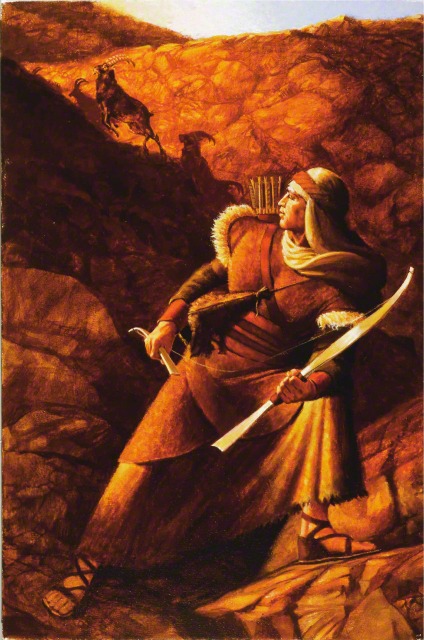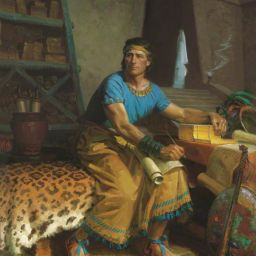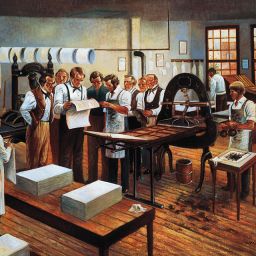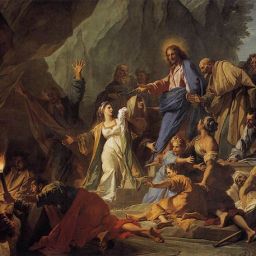The Book of Mormon contains many many cultural clues that give away its true heritage. We can look at the behaviors of the “characters” in the Book of Mormon to gain a better understanding of the views of the author of the text. For example, when a book has a main character that is unrealistically lacking in flaws or weaknesses, we call that a “Mary Sue,” which is typically recognized as the author inserting themselves into the text. When we read the Book of Mormon, however, we don’t find Joseph Smith, or his politics, or his American ideals. Instead we find the traits of ancient Israel, Arabia and Mesoamerica. Here are just a few of my favorite examples:
SINGING ARABIC POETRY – Did you notice the poem in 1 Nephi? No? That’s probably because you aren’t familiar with ancient Arabian poetry. Lehi is moved to a spontaneous exhortation to his sons at a notable camp site in the Book of Mormon. These verses correspond exactly with the precise pattern of an ancient Arabic poetic form called a “qasid” which required 7 steps to be complete: inspired by water, addressed to two traveling companions, praise of the scene, urge the traveler to be like the object inspiring the poem, is an extemporaneous reciting of great emotion, are very short, each couplet must be followed by it’s “brother” making a matched pair. (Nibley, Lehi in the Desert, 1988) This just blows my mind.
OFFERINGS IN TRAVELS – The Book of Mormon highlights three times Lehi offered sacrifices and twice when he offered burnt offerings. No big deal, right? Well, it turns out the ancient Israelites had rules about that sort of thing and these offerings and sacrifices correspond exactly with ancient Mosaic law in regards to travelers specifically – the kind of detail it would be easy to get wrong. (Brown, New Light from Arabia on Lehi’s Trail, 2002)
SHEREM’S DIVINE DEATH – Sherem’s death seems harsh to modern readers, but it turns out his accusation against Jacob was a capital offense in pre-exilic law – something Joseph probably never knew – making his death sentence appropriate to the law of the age exactly. Did you know that falsely accusing somebody of blasphemy was a capital offense? I sure didn’t. (Welch J. W., The Legal Cases in the Book of Mormon, 2008)
THEM VALLEYS ARE STRONG – The Book of Mormon people use phrases like “strong valleys” instead of what 1800s Americans would say, like “strength of the hills” or “strong mountains.” In ancient Araby, the valleys were shelters and “strong” places of refuge. (Nibley, Lehi in the Desert, 1988) A frontier american author would never have thought to make that change in their own writing.
I DEMOCRATICALLY APPOINT MY BLOODLINE AS JUDGE FOREVER – The Book of Mormon, allegedly created by a red-blooded patriotic American, has more in common with Meso-American political systems than those with which the people in 1830 would have been familiar. Councils, hereditary leaders, hereditary “judgeships,” and, especially, parts of the story of Ammon. (Bushman, 2012) Even before that point, Jacob records that the kings were given the same name as their predecessors, being called second Nephi, third Nephi, and so forth. An odd way of doing things, but precisely the pattern observed by Diego de Landa during the Spanish conquest, who recorded that the rulers were validated by their genealogy, and that “The name of the father is transmitted to his son.” (Landa, Yucatan Before and After the Conquest, 2012)
“The Book of Mormon is not a conventional American book. Too much Americana is missing. Understanding the work requires a more complex and sensitive analysis than has been afforded it. Historians will take a long step forward when they free themselves from the compulsion to connect all they find with Joseph Smith’s America and try instead to understand the ancient patterns deep in the grain of the book.” – Richard L. Bushman, Historian
CURSING AN OPPONENT WITH SPEECHLESSNESS – In the Book of Mormon, in the midst of a heated legal dispute, Alma curses Korihor to be struck dumb. It’s an odd choice, but it turns out ancient legal records from the Mediterranean area around the time of Lehi show that asking god to curse your opponent with speechlessness while in a lawsuit was a common practice. After all, if they can’t speak, they can’t win the lawsuit! This ancient practice would have, of course, been totally unknown to Joseph Smith. (Welch J. W., A Steady Stream of Significant Recognitions, 2002)

HUMILIATION THROUGH BEATINGS – When Laman and Lemuel become frustrated with Nephi after their failed attempt to retrieve the brass plates, they yell at Nephi and Sam, and beat them – not with their fists, but with a rod. In ancient near-eastern culture every free man carried a stick as a badge of independence and authority, and they use the stick to assert their authority and superiority over the workman or day-laborers by beating them. This was so common that their underlings are even called ‘stick servants.’ (Nibley, An Approach to the Book of Mormon, 1988) Clearly Laman and Lemuel were trying to put Nephi in his place for his disastrous plan which cost them their precious property. But how would Joseph Smith know this cultural tradition, and why would he make such an odd choice when he grew up in the era where fistfights were a main way used to settle disputes? (Ungar, 2010)
LAWYERS AND JUDGES -The Book of Mormon people adopt a legal system that uses “Judges” who not only rule on the law, but carry out the law, make the law, judge a case, and so on, acting more as kings than judges as we know them. Moreover, they had “lawyers” in their system – certainly an unheard-of development for groups such as the plains Indians or the tribes of the northeast United States. Once again, we find Mesoamerican culture matches the Book of Mormon prediction, with laws, judges, and lawyers. (Tarlton Law Library, 2018)
SUPER COMPLEX POLITICAL STRUCTURE – The Book of Mormon describes the peoples as living in individual political states with varying relationships from trade, subjugation, alliance, or larger political hierarchies. Leadership is legitimized through political connection and lineage, and sub-leaders can be independent or part of the hierarchy. Each of these “states” had a ruler, but also a supreme military commander responsible for strategy and bringing troops to battle. That’s a LOT of cultural guesswork, and once again, it’s all borne out precisely in the cultures of ancient Mesoamerica. (Tarlton Law Library, 2018)
OW, MY ARMS – One especially disturbing story from the Book of Mormon describes soldiers presenting severed arms to a king as evidence of the impressive act of Ammon. This is a shocking display, but the tradition of displaying severed arms as trophies of valor continued on for centuries, as Spanish conquerors discover native people displaying severed arms to impress women or gaining the right to dress in fine clothing by cutting off the arms of an enemy. (Yerman, 1999)
SKIN COLOR AND CANNIBALISM – The Book of Mormon authors assert that the Nephite people were “fair” and that this group of lighter-skinned people eventually became horribly evil, even resorting to cannibalism, and are eventually all wiped out. Multiple Native American tribes hold an oral tradition of a group of “white giants” who arrived by boats, expanded from the west and who were or became cannibals until they were wiped out. (Macisaac, 2015)
THE BOW AS SYMBOLIC FOR LEADERSHIP – In the Book of Mormon, when the family of Lehi struggles in the wilderness, Nephi’s fine bow breaks. The bows of his older brothers have lost their spring and are therefore useless. Nephi ends up making his own new bow and submissively goes to his priesthood leader, his father, to ask where to hunt. From that point on, Nephi begins to be the leader of the “tribe,” receiving the revelations that will guide the family, acting as authority. It’s only after this point that his brothers begin to accuse him of usurping authority as well. Nephi would have recognized this symbolism and likely seen it as an omen or even a divine approval of his right to lead. Joseph Smith, on the other hand, would have had no idea of the symbolism of the bow. (Goff, 1989)
ASHERAH – The Book of Mormon includes an extended vision focused around the Tree of Life and those who seek after the fruit of the tree. When the young prophet Nephi asks for an interpretation of the meaning of the images he sees he is shown Mary, the mother of Jesus Christ, as the meaning behind the tree. To modern readers who don’t worship Mary, this seems odd. Yet to Israelites of the time of Lehi, worship of the divine feminine- the mother of God – called Asherah was both widespread and fairly
conservative. What was Asherah’s symbol? The white tree with fruit glowing like flames. (Petersen, 2002)
References
Brown, S. K. (2002). New Light from Arabia on Lehi’s Trail. In D. W. Parry, D. C. Peterson, & J. W. Welch, Echoes and Evidences of the Book of Mormon. Maxwell Institute.
Bushman, R. (2012, February 3). Joseph Smith’s Presidential Campaign. (R. Bushman, Performer) Columbia University, New York City, New York, United States of America.
Landa, D. d. (2012). Yucatan Before and After the Conquest. Courier Corporation.
Macisaac, T. (2015, 11 29). Ancient Race of White Giants Described in Native Legends From Many Times. Retrieved from Epoch Times: https://www.theepochtimes.com/ancient-race-of-white-giants-described-in-native-legends-from-many-tribes_1871411.html
Nibley, H. (1988). An Approach to the Book of Mormon. Salt Lake City: Deseret Book Company.
Nibley, H. (1988). Lehi in the Desert. Salt Lake City: Deseret Books.
Petersen, D. C. (2002). Not Joseph’s, and Not Modern. In D. W. Parry, D. C. Peterson, & J. W. Welch, Echoes and Evidences of the Book of Mormon. Maxwell Institute. Retrieved from Maxwell Institute: https://publications.mi.byu.edu/fullscreen/?pub=1082&index=3
Tarlton Law Library. (2018, 11 8). Aztec and Maya Law. Retrieved from Tarlton Law Library Jamail Center for Legal Research: http://tarlton.law.utexas.edu/aztec-and-maya-law/maya-legal-system-sources-law
Tarlton Law Library. (2018, 11 8). Maya Political Structure. Retrieved from Tarlton Law Library Jamail Center for Legal Research: http://tarlton.law.utexas.edu/aztec-and-maya-law/maya-political-structure
Ungar, R. (2010, 10 2). The Boxing Discourse in Late Georgian England, 1780-1820: A Study in Civic Humanism, Gender, Class and Race. Retrieved from Humboldt-Universität zu Berlin: https://edoc.hu-berlin.de/bitstream/handle/18452/17268/ungar.pdf?sequence=1
Welch, J. W. (2002). A Steady Stream of Significant Recognitions. In D. W. Parry, D. C. Peterson, & J. W. Welch, Echoes and Evidences of the Book of Mormon. Maxwell Institute.
Welch, J. W. (2008). The Legal Cases in the Book of Mormon. Provo: Brigham Young University Press, Neal A. Maxwell Institute for Religious Scholarship.
Yerman, B. H. (1999). Ammon and the Mesoamerican Custom of Smiting off Arms. Journal of Book of Mormon Studies.









